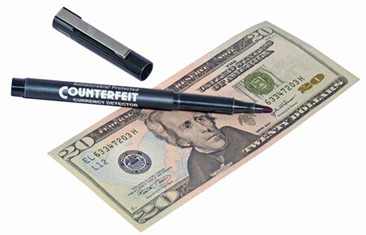Posted on 07/23/2023 7:42:29 AM PDT by SunkenCiv
During his career, Franklin printed nearly 2,500,000 money notes for the American Colonies...
However, one major problem stood in the way of efforts to print paper money: counterfeiting. When Franklin opened his printing house in 1728, paper money was a relatively new concept. Unlike gold and silver, paper money's lack of intrinsic value meant it was constantly at risk of depreciating. There were no standardized bills in the Colonial period, leaving an opportunity for counterfeiters to pass off fake bills as real ones. In response, Franklin worked to embed a suite of security features that made his bills distinctive...
One of the most distinctive features they found was in Franklin's pigments. Manukyan and his team determined the chemical elements used for each item in Notre Dame's collection of Colonial notes. The counterfeits, they found, have distinctive high quantities of calcium and phosphorus, but these elements are found only in traces in the genuine bills.
Their analyses revealed that although Franklin used (and sold) "lamp black," a pigment created by burning vegetable oils, for most printing, Franklin's printed currency used a special black dye made from graphite found in rock. This pigment is also different from the "bone black" made from burned bone, which was favored both by counterfeiters and by those outside Franklin's network of printing houses.
Another of Franklin's innovations was in the paper itself. The invention of including tiny fibers in paper pulp — visible as pigmented squiggles within paper money — has often been credited to paper manufacturer Zenas Marshall Crane, who introduced this practice in 1844. But Manukyan and his team found evidence that Franklin was including colored silks in his paper much earlier.
(Excerpt) Read more at news.nd.edu ...
The other GGG topics added since the previous digest ping, alpha sort:
These got pinged at the time, but were missed in the respective Digests of that week:
“Researchers decipher the secrets of Benjamin Franklin’s paper money”
I suspect that one secret is that when people looked behind the currency they saw gold.
Wow, amazing info about Franklin.
That was pretty clever with the black ink being made from graphite. All anyone would have had to do to spot a counterfeit was to run a bit of the ink through a mass spectrometer.

Very I teresti g I deed.
Whoops, lost my “ “ key
But yeah, Ben led a fascinating life for sure.
Interesting article. The only question I have is this. How would somebody of that era have detected said security measures? Particularly the ink composition?
The graphite ink may simply have been shinier. Just speculating.
Ol’ Ben was a pretty smart guy.
They were of obviously higher quality material, and counterfeits were typically not too great. Although, the CSA paper money was so poorly printed that counterfeiters often got caught because their bills were better. :^)
Must have had an extra ingredient that kept it from smudging?
Thanks. That is a funny sidenote about CSA currency.
One clever way of foolproof authentication that was used back in the day, England had what were called Tally sticks, I think used for mortgages. They would split a piece of wood in two, they fit together only one way and the grain of course was unique.
It was Franklin (I think, or Jefferson) who said “Paper is not Money, it is the Ghost of Money”.
Finance was a lot different back then. I think lenders screwed over a lot of the founding fathers or colonists by demanding repayment in gold, interest rate fluctuations seasonally. Also in those days, an Estate passed on debts as well as assets, so the heir was on the hook for obligations incurred by dear old Dad.
And they had Debtor’s prisons. They’d have thrown all those college kids in Jail for not paying their loans off, probably. Sometimes, the old ways are best ways, eh?
Yeah, that’s for sure!
https://www.fi.edu/en/benjamin-franklin-faq
Ben’s Franklin’s Money sidebar:
Ben Franklin’s Last Will & Testament
By Ric Edelman
https://wecanrise.com/ben-franklins-will/
[snip] By the time he died on April 17, 1790, Ben Franklin was one of the wealthiest men in the United States. In his will, he bequeathed 1,000 pounds sterling each to the cities of Boston and Philadelphia — worth roughly $119,000 in 2019 dollars — with the instructions that much of the money remain untouched for 100 years and the rest untouched for 200 years. [/snip]
A pity Franklin never thought of a way to stop the government from making dollars nearly worthless by printing trillions of them.
A little bit later, every store or shop of any size had a periodical that published pictures of every type of local or state bank currency, hundreds of them. I think that was to help authenticate and spot counterfeits, but it also listed the going rate or discount. A $10 bill from a given bank would not necessarily be spent at par, depending on the perceived soundness of the bank issuing it. It was a real mess, and one reason a central bank was considered an improvement.
> They’d have thrown all those college kids in Jail for not paying their loans off, probably. Sometimes, the old ways are best ways, eh?
Nah. They’d just use the time in prison to work on their masters and PhDs. Throw modern college kids in jail for not paying their debts and you’d wind up with more community organizers, environmental activists, and public defenders than you could ever possibly use.
not a lot of engravers of excellence around either.
Disclaimer: Opinions posted on Free Republic are those of the individual posters and do not necessarily represent the opinion of Free Republic or its management. All materials posted herein are protected by copyright law and the exemption for fair use of copyrighted works.